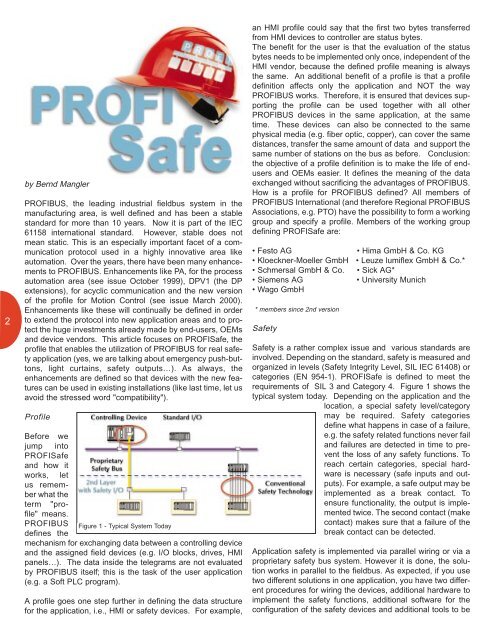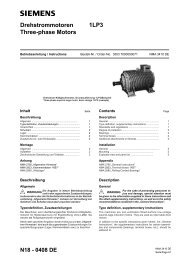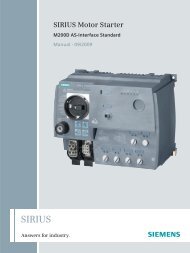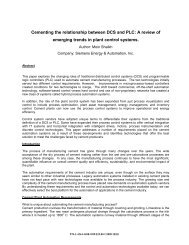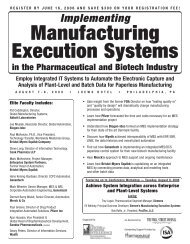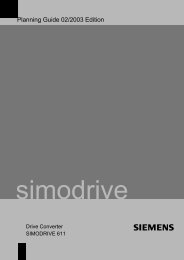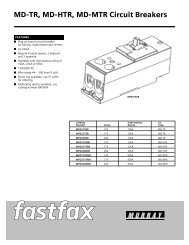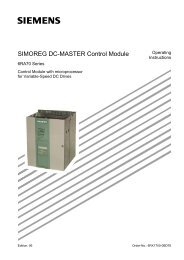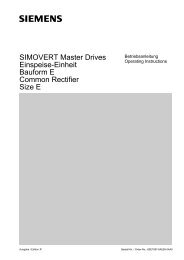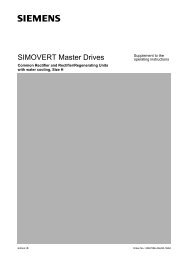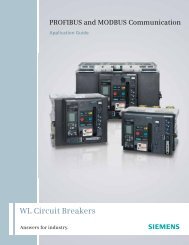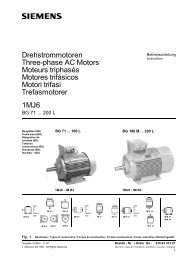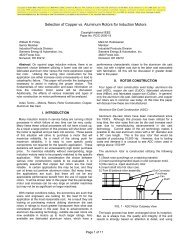PROFISafe NEW PRODUCTS DEVELOPMENT KIT ... - Siemens
PROFISafe NEW PRODUCTS DEVELOPMENT KIT ... - Siemens
PROFISafe NEW PRODUCTS DEVELOPMENT KIT ... - Siemens
You also want an ePaper? Increase the reach of your titles
YUMPU automatically turns print PDFs into web optimized ePapers that Google loves.
2by Bernd ManglerPROFIBUS, the leading industrial fieldbus system in themanufacturing area, is well defined and has been a stablestandard for more than 10 years. Now it is part of the IEC61158 international standard. However, stable does notmean static. This is an especially important facet of a communicationprotocol used in a highly innovative area likeautomation. Over the years, there have been many enhancementsto PROFIBUS. Enhancements like PA, for the processautomation area (see issue October 1999), DPV1 (the DPextensions), for acyclic communication and the new versionof the profile for Motion Control (see issue March 2000).Enhancements like these will continually be defined in orderto extend the protocol into new application areas and to protectthe huge investments already made by end-users, OEMsand device vendors. This article focuses on <strong>PROFISafe</strong>, theprofile that enables the utilization of PROFIBUS for real safetyapplication (yes, we are talking about emergency push-buttons,light curtains, safety outputs…). As always, theenhancements are defined so that devices with the new featurescan be used in existing installations (like last time, let usavoid the stressed word "compatibility").ProfileBefore wejump into<strong>PROFISafe</strong>and how itworks, letus rememberwhat theterm "profile"means.PROFIBUS Figure 1 - Typical System Todaydefines themechanism for exchanging data between a controlling deviceand the assigned field devices (e.g. I/O blocks, drives, HMIpanels…). The data inside the telegrams are not evaluatedby PROFIBUS itself; this is the task of the user application(e.g. a Soft PLC program).A profile goes one step further in defining the data structurefor the application, i.e., HMI or safety devices. For example,an HMI profile could say that the first two bytes transferredfrom HMI devices to controller are status bytes.The benefit for the user is that the evaluation of the statusbytes needs to be implemented only once, independent of theHMI vendor, because the defined profile meaning is alwaysthe same. An additional benefit of a profile is that a profiledefinition affects only the application and NOT the wayPROFIBUS works. Therefore, it is ensured that devices supportingthe profile can be used together with all otherPROFIBUS devices in the same application, at the sametime. These devices can also be connected to the samephysical media (e.g. fiber optic, copper), can cover the samedistances, transfer the same amount of data and support thesame number of stations on the bus as before. Conclusion:the objective of a profile definition is to make the life of endusersand OEMs easier. It defines the meaning of the dataexchanged without sacrificing the advantages of PROFIBUS.How is a profile for PROFIBUS defined? All members ofPROFIBUS International (and therefore Regional PROFIBUSAssociations, e.g. PTO) have the possibility to form a workinggroup and specify a profile. Members of the working groupdefining <strong>PROFISafe</strong> are:• Festo AG• Hima GmbH & Co. KG• Kloeckner-Moeller GmbH • Leuze lumiflex GmbH & Co.*• Schmersal GmbH & Co. • Sick AG*• <strong>Siemens</strong> AG• University Munich• Wago GmbH* members since 2nd versionSafetySafety is a rather complex issue and various standards areinvolved. Depending on the standard, safety is measured andorganized in levels (Safety Integrity Level, SIL IEC 61408) orcategories (EN 954-1). <strong>PROFISafe</strong> is defined to meet therequirements of SIL 3 and Category 4. Figure 1 shows thetypical system today. Depending on the application and thelocation, a special safety level/categorymay be required. Safety categoriesdefine what happens in case of a failure,e.g. the safety related functions never failand failures are detected in time to preventthe loss of any safety functions. Toreach certain categories, special hardwareis necessary (safe inputs and outputs).For example, a safe output may beimplemented as a break contact. Toensure functionality, the output is implementedtwice. The second contact (makecontact) makes sure that a failure of thebreak contact can be detected.Application safety is implemented via parallel wiring or via aproprietary safety bus system. However it is done, the solutionworks in parallel to the fieldbus. As expected, if you usetwo different solutions in one application, you have two differentprocedures for wiring the devices, additional hardware toimplement the safety functions, additional software for theconfiguration of the safety devices and additional tools to be


